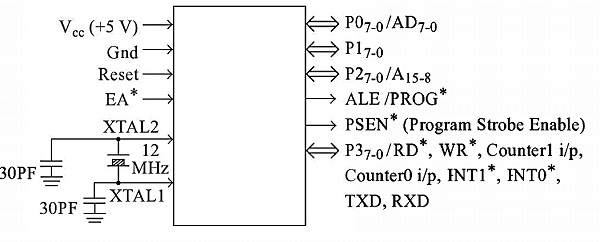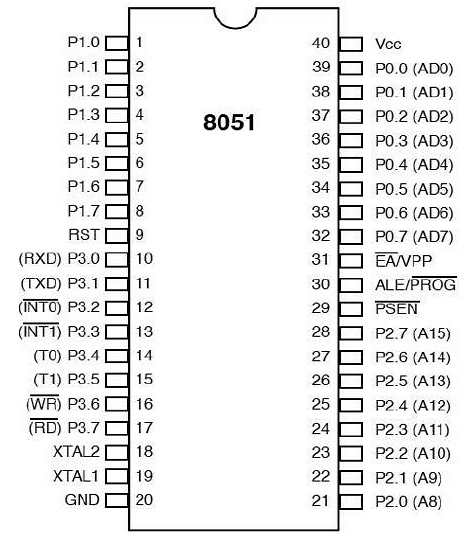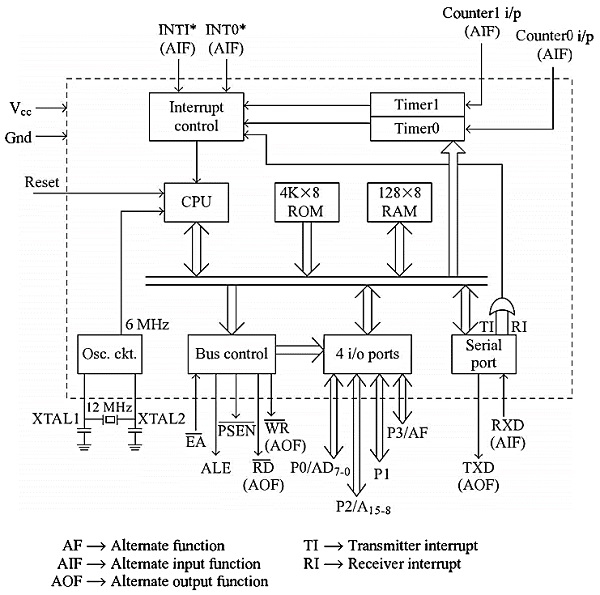
 Data Structure
Data Structure Networking
Networking RDBMS
RDBMS Operating System
Operating System Java
Java MS Excel
MS Excel iOS
iOS HTML
HTML CSS
CSS Android
Android Python
Python C Programming
C Programming C++
C++ C#
C# MongoDB
MongoDB MySQL
MySQL Javascript
Javascript PHP
PHP
- Selected Reading
- UPSC IAS Exams Notes
- Developer's Best Practices
- Questions and Answers
- Effective Resume Writing
- HR Interview Questions
- Computer Glossary
- Who is Who
Functional blocks of Intel 8051
There are various versions of 8051 Microcontroller. These versions are 8051H, 8051BH and 8051CH. Here we will see the general 8051 Microcontroller. This microcontroller works on a +5V dc power source. As it has on-chip clock circuit, so we need only the crystal oscillator between the pin XTAL1 and XTAL2 with two additional capacitors. As we have mentioned that the general clock frequency is 12MHz, but some other version of 8051 uses 20MHz crystal oscillator. There is a clock dividing circuit to divide the clock frequency to provide an internal clock pulse. So for 12MHz clock, it is divided into a 6MHz clock.
The functional diagram ofIntel 8051 is looking like this.

As we know there are 40 pins in 8051. The actual Pin Diagram is like this.

Now let us see the different pins and their functions:
| Pin Numbers |
Description |
|---|---|
|
1 to 8 |
These are Port 1 pins. Using this port, we cannot do some other tasks. It is internally pulled up, bi-directional IO port |
|
9 |
This is the RESET pin. Using this pin, the microcontroller can be reset to its initial values. |
|
10 to 17 |
These are Port 3. This port can do some special tasks like interrupt, timer inputs, serial communications etc. |
|
18, 19 |
These pins are for interfacing the external crystal oscillator to get the system clock. |
|
20 |
It is GND (Ground) pin of the microcontroller. It is related to the power supply. |
|
21 to 28 |
These are port 2 pins. This port is used as IOport. The higher order address bus signal can also be multiplexed by this ports. |
|
29 |
It is PSEN (Program Store Enable). It is used to read the signal from external program memory. |
|
30 |
This is ALE (Address Latch Enable) pin. This pin is used to demultiplex the address-data signal of the port. |
|
31 |
This is EA (External Access Input) pin. This pin can enable or disable the external memory interfacing. |
|
32 to 39 |
These are known as Port 0. It also serves as IOports. The lower order address and data bus signals are multiplexed using this port. |
|
40 |
This is Vcc pin. This pin is used to provide the positive supply to the Chip. |
We know that 8051 has 4kbof ROM storage and 128 bytes of internal RAM storage. It also has two16-bit timers, and four 8-pit ports. These ports are programmable as well as addressable as per requirement. The 8051 has On-Chip crystal oscillator of 12MHz.
We can drive 8051 also using the external clock sources. So to use external clock sources, there are XTAL1 and XTAL2 pins in the microcontroller.
8051 has four 8-bit IOports called Port0, Port1, Port2 and Port3. When the internal data orprogram are not adequate for some applications then the external memory is used. So in this case he Port2 holds the MS bits (A15– 8) and the Port0 pins provide the LSbits (AD7 – 0)of address. The ALE (Address Latch Enable) pin is same as the ALE pin of 8085. When it is high, it indicates that the Port0 holds the lower order address bits. And when ALE is low, it indicates Port0 is holding the data bits.
Two pins in Port3 is used to send out the RD (read) and WR (write) signals to external data memory. The T0and T1 pins are used for counter inputs. The RXD and TXD pins are used for the UART for serial communication. The INT0 and INT1 pins are used for two interrupt input pins. So when the external memory is used, there is only one port (Port1) for IO operations.
Now let us see a simplified block diagram of 8051.

So from this diagram we can see the entire structure of 8051, and different pins and interconnectivity of them.

